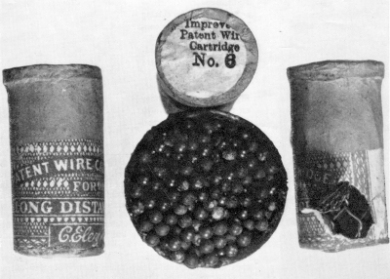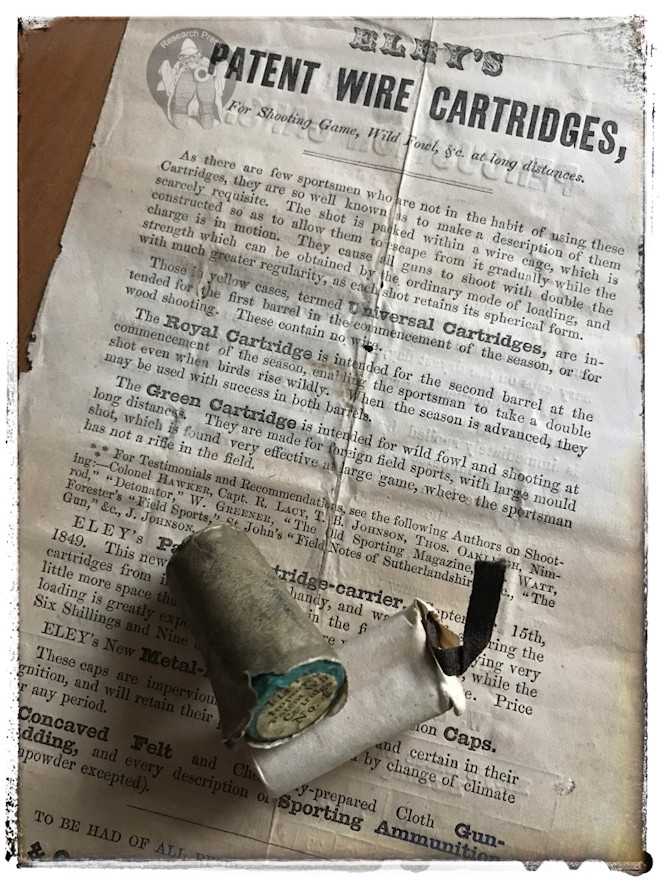You are here: Home > Firearms > Ammunition
Written by: W.S. Curtis
The term ‘Cartridge’ in the context of the muzzle loading era did not always mean ‘a complete round with powder’. In shotgun terms, it meant a package containing the shot charge and possibly the wadding which could be loaded intact onto the powder charge already in the barrel. This formerly meant a simple paper wrapped package of shot. It was thought that the degree of scatter from shot barrels was too great and the pre-packaging tended to reduce scatter by protecting the shot pellets lying next to the bore from being rubbed along it and deformed. Thought was given to the idea of trying to extend the range of shot by keeping it together for some distance from the muzzle. The first patent recorded for the so-called Wire Cartridge was that of Joshua Jenour, Patent No. 5570 of November 28, 1827. ‘The Cartridge is made of wire, woven with meshes so wide as to allow the shot to be scattered’. The Patent was bought and developed by Eley Brothers, the London firm who made percussion caps, and who then marketed their Patent Wire Cartridge for muzzle loading guns. The first published accounts of this new idea appear in the 1830 (6th Edition) of Colonel Peter Hawker’s INSTRUCTIONS TO YOUNG SPORTSMEN, IN ALL THAT RELATES TO GUNS AND SHOOTING, London 1830 (Riling 373). Hawker found that the wire mesh was too fine and too stiff causing, in a percentage of the shots fired, a failure to disperse the shot from the package thus causing it to become a dangerous solid projectile. Hawker’s book was also published in the USA in an abbreviated form with an appendix on American hunting and shooting by William T. Porter (Philadelphia 1846). The report on the Wire Cartridge in this edition has been abbreviated too much to make a lot of sense.
There was another patent, that of Thomas French Berney, Patent No. 8143 of July 6, 1839. ‘Cartridges are made with two cases, an inner one formed of spiral wire for containing the shot, and an outer case of paper‘ although his name does not appear in any works that I have studied.

The cartridges were constructed using a cylindrical cage of wire mesh with an outer paper layer attached to a stiff card wad which was then packed with shot (in the USA ‘bird-shot’?) mixed with bone dust which kept it steady in the package and helped to prevent the shot deforming. The end was closed off and a paper wad was pasted over it. The card wad at the other end was a tight fit in the bore and the part containing the shot rather smaller. After the powder charge was loaded, the cartridge was inserted with the thinner shot end next to the powder and the stiff wad on top. This seems illogical at first glance but the idea was that the card wad would hold everything in place and the final ramming combined with the shock of the discharge would cause the paper sleeve to rupture so that the shot could escape through the interstices of the wire mesh in flight. The cartridge was labelled at each end with the shot size and given an outer wrapping provided with a piece of tape to tear it open for loading. The shot size label was also on the end of the outer wrapper. The whole lot were then put up in packets of ten, often with an instruction leaflet enclosed.
The system seems to have lasted into the early breech-loading period until the introduction of the choke bore. The later cartridges are marked ‘For Breech Loaders‘ and are intended to be loaded into pin-fire and centre-fire cases. These do not seem to have used the outer paper wrapper.
It was soon found that in some circumstances the extended range was too great and this gave rise to three different categories identified by colour coding their paper. The longest range was coloured green and was referred to as ‘The Green‘. This was defined as being for wildfowl and dangerous except in wide open spaces. The regular wire cartridge was ‘The Royal‘, coloured blue, which was intended for the second barrel to give some extra range when walking up game. The third category was ‘The Universal‘, coloured yellow, which was made without any wire in its construction.
Pictured above are three original ELEY wire cartridges, one opened to show wire cage and shot content. (Guns Review, February 1964)
Instruction leaflets were included in the packets of cartridges.
